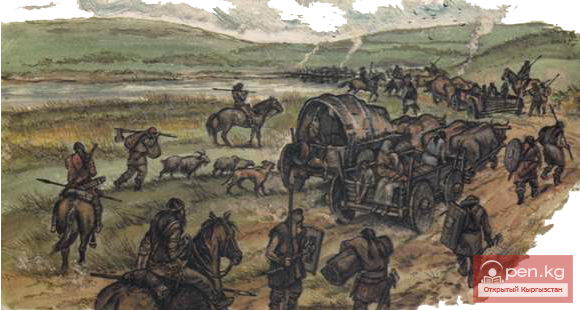
The Karakhanid Kingdom...

Legends. In the first half of the 12th century, it is likely that the "Karakhanid"...

Karluks...

The Last Eastern Karakhanid Khans. According to the information from "Majmu...

All political entities of the Middle Ages in the territory of Central Asia somehow affected the...

Turkic Beilik In the work "Hudud al-'alam," the word "Turk" appears as...

In Central Asia, the Great Turkic Khaganate (552-744 years) emerges. The Turks considered Ashina,...

Ancient People — Kyrgyz The Kyrgyz, whose roots go deep into antiquity, lost in the darkness of...

The second half of the first millennium is characterized by the formation and development of early...

The city of Uzgen was founded in the 8th-9th centuries on a steep terrace of the Kara-Darya River....

«Talas» beylik...

Chigili. Chinese sources from the mid-7th century, as part of the Karluk union, mention certain —...

The Influence of Islam on Kyrgyz Rituals On the map of the Liao era (916—1125) and Northern Song...

“Descendants of Afrasiab” and Ilek-khans In the surviving Eastern written sources, the Karakhanid...

Writings of "Shajarat al-Atrak" In the anonymous work "Shajarat al-Atrak,"...

The structure, organization, and supply of the armed forces of the Kyrgyz during that period were...

Ibrahim ibn Ahmed. This may refer to events related to the struggle of the great khan Ahmed, the...

The Saka tribes were divided into three parts. In the southern regions of Kyrgyzstan lived the...

Kyrgyz Great Power During the VI-VIII centuries, when the Kyrgyz state existed only in the...

The formation of the Kyrgyz people is connected with ethnic processes in ancient and medieval...

Weis-Khan After Ulugh Beg's campaign in 1425, the struggle for the throne of Moghulistan...

Since the Sakas did not have a centralized state, they did not conduct a specific foreign policy....

The Infiltration of Yenisei Kyrgyz into the Tian Shan Our task is to examine the issues regarding...

The traces of primitive human activity in the territory of the Kyrgyz Republic date back to the...

The situation in Central Asia. In the early 16th century, feudal fragmentation intensified not...

The Struggle for the Throne in Moghulistan in the Second Half of the 16th Century Abd al-Karim...

Social and Economic Development of Mogulistan There is very little information in written sources...

Ethnic Situation in the Tian Shan in the Middle Ages A comparative analysis of sources and early...

Historical Roots of the City Let us return to those deep historical roots that connect our...

Ibrahim ibn Ahmed and Anal-Hakk Thus, the "progenitor" of the Kyrgyz ethnicity of the...

Burana - Architectural Heritage. Located 12 km southwest of the present-day town of Tokmak is the...

The ethnonyms “Turk” and “Turkut” were first mentioned in a Chinese chronicle from the year 546....

Facts Supporting the Statement of Prominent Soviet Ethnographer and Kyrgyz Scholar S. M. Abramzon...

Kyrgyzstan is one of the world’s centers of human emergence, statehood, and civilization. The life...

The Basis of the “Great Campaign” in the Epic of “Manas” According to Ibn al-Asir (“Kitab...

Kyrgyzstan - Chronology of Major Historical Events 400,000 years ago - The oldest Stone Age...

Petition of Kyrgyz Deputies for the Creation of National Statehood After losing their statehood in...

The economy of Kyrgyzstan during the era of Turkic states experienced syncretic development (a...

Kyrgyz K. A. Pishulina rightly points out that only those tribes and clans that participated in...

During the era of the Karakhanid khanate, Turkic peoples achieved significant progress in science...

Peak of Semenov-Tian-Shansky — a mountain peak in the Central Tian Shan in Kyrgyzstan. The highest...

A new stage in the study of the history, population, economy, and nature of Kyrgyzstan began after...

The Struggle of the Kyrgyz Against the Uyghur Kaganate After the eastern Turks, who rose up...

Bulghachi, Dolony, Duglaty, Dukhtui Bulghachi (bulghachi-dalkar, bulghachi-vilkar,...

Balasagun One of the capitals of the Karakhanid state was the city of Balasagun, located in the...

Movement of the Altai Kyrgyz to the Western Regions of Mogolistan In the study of the...

The Turkic states pursued an active foreign policy and participated in geopolitical games in the...

During the period in question, Kyrgyzstan was unable to conduct any foreign policy. However,...